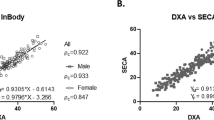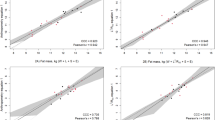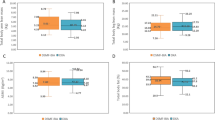Abstract
Objective:
To evaluate air-displacement plethysmography (ADP) and bioelectrical impedance analysis (BIA) vs dual-energy X-ray absorptiometry (DXA) for the assessment of fat-free mass (FFM) in healthy elderly subjects.
Subjects:
Forty-two women and twenty-six men aged 60–84 years.
Methods:
FFM was measured by DXA and ADP. Body impedance (Z) was measured by four-polar BIA and the impedance index (ZI) was calculated as stature2/Z. Selection of predictors (gender, age, weight and ZI at 5, 50 and 100 kHz) for BIA algorithms was carried out using bootstrapped stepwise linear regression on 1000 samples of 68 subjects. Limits of agreement were used as measures of interchangeability of ADP and BIA with DXA.
Results:
The limits of agreement of ADP vs DXA were −11.0 to 2.4 kg in males and −4.8 to 2.2 kg in females. Gender, weight and ZI100 were selected as predictors of FFM by bootstrapped stepwise linear regression. In males, ZI100 (−12.2 to 12.2 kg) was much less accurate than weight (−6.0 to 6.0 kg) at predicting FFM and their combination did not improve the estimate (−6.0 to 6.0 kg). In females, ZI100 (−6.8 to 6.8 kg) was less accurate than weight (−5.6 to 5.6 kg) at predicting FFM and their combination improved the estimate only slightly (−5.0 to 5.0 kg).
Conclusions:
In healthy elderly subjects, (1) ADP and DXA are not interchangeable for the assessment of FFM, especially in males; and (2) ZI100 is not superior to weight for the prediction of FFM and their combination is of little advantage and only in females.
This is a preview of subscription content, access via your institution
Access options
Subscribe to this journal
Receive 12 print issues and online access
$259.00 per year
only $21.58 per issue
Buy this article
- Purchase on SpringerLink
- Instant access to full article PDF
Prices may be subject to local taxes which are calculated during checkout

Similar content being viewed by others
References
Alemán-Mateo H, Huerta RH, Esparza-Romero J, Méndez RO, Urquidez R, Valencia ME (2007). Body composition by the four-compartment model: validity of the BOD POD for assessing body fat in Mexican elderly. Eur J Clin Nutr 61, 830–836.
Bedogni G, Marra M, Bianchi L, Malavolti M, Nicolai E, De Filippo E et al. (2003). Comparison of bioelectrical impedance analysis and dual-energy X-ray absorptiometry for the assessment of appendicular body composition in anorexic women. Eur J Clin Nutr 57, 1068–1072.
Bedogni G, Pietrobelli A, Heymsfield SB, Borghi A, Manzieri AM, Morini P et al. (2001). Is body mass index a measure of adiposity in elderly women? Obes Res 9, 17–20.
Bosy-Westphal A, Mast M, Eichhorn C, Becker C, Kutzner D, Heller M et al. (2003). Validation of air-displacement plethysmography for estimation of body fat mass in healthy elderly subjects. Eur J Nutr 42, 207–216.
Brambilla P, Bedogni G, Moreno LA, Goran MI, Gutin B, Fox KR et al. (2006). Crossvalidation of anthropometry against magnetic resonance imaging for the assessment of visceral and subcutaneous adipose tissue in children. Int J Obes Relat Metab Disord 30, 23–30.
Chumlea WC, Guo SS, Kuczmarski RJ, Flegal KM, Johnson CL, Heymsfield SB et al. (2002). Body composition estimates from NHANES III bioelectrical impedance data. Int J Obes Relat Metab Disord 26, 1596–1609.
Deurenberg P (1994). International Consensus Conference on impedance in body composition. Age Nutr 5, 142–145.
Fields DA, Hunter GR (2004). Monitoring body fat in the elderly: application of air-displacement plethysmography. Curr Opin Clin Nutr Metab Care 7, 11–14.
Fields DA, Higgins PB, Radley D (2005). Air-displacement plethysmography: here to stay. Curr Opin Clin Nutr Metab Care 8, 624–629.
Gallagher D, Visser M, De Meersman RE, Sepúlveda D, Baumgartner RN, Pierson RN et al. (1997). Appendicular skeletal muscle mass: effects of age, gender, and ethnicity. J Appl Physiol 83, 229–239.
Gonçalves S, White H (2005). Bootstrap standard error estimates for linear regression. J Am Stat Ass 100, 970–979.
Guo SS, Chumlea WC, Cockram DB (1996). Use of statistical methods to estimate body composition. Am J Clin Nutr 64, 428S–435S.
Harrell FE (2001). Regression Modeling Strategies: With Applications to Linear Models, Logistic Regression, and Survival Analysis. Springer: New York.
Heymsfield SB, Nuñez C, Testolin C, Gallagher D (2000). Anthropometry and methods of body composition measurement for research and field application in the elderly. Eur J Clin Nutr 54 (Suppl 3), S26–S32.
Jensen GL (2005). Obesity and functional decline: epidemiology and geriatric consequences. Clin Geriatr Med 21, 677–687.
Kennedy RL, Chokkalingham K, Srinivasan R (2004). Obesity in the elderly: who should we be treating, and why, and how? Curr Opin Clin Nutr Metab Care 7, 3–9.
Kyle UG, Genton L, Hans D, Karsegard L, Slosman DO, Pichard C (2001). Age-related differences in fat-free mass, skeletal muscle, body cell mass and fat mass between 18 and 94 years. Eur J Clin Nutr 55, 663–672.
Kyle UG, Pirlich M, Lochs H, Schuetz T, Pichard C (2005). Increased length of hospital stay in underweight and overweight patients at hospital admission: a controlled population study. Clin Nutr 24, 133–142.
Ludbrook J (2002). Statistical techniques for comparing measurers and methods of measurement: a critical review. Clin Exp Pharmacol Physiol 29, 527–536.
Malavolti M, Mussi C, Poli M, Fantuzzi AL, Salvioli G, Battistini N et al. (2003). Cross-calibration of eight-polar bioelectrical impedance analysis versus dual-energy X-ray absorptiometry for the assessment of total and appendicular body composition in healthy subjects aged 21–82 years. Ann Hum Biol 30, 380–391.
Pietrobelli A, Heymsfield SB, Wang ZM, Gallagher D (2001). Multi-component body composition models: recent advances and future directions. Eur J Clin Nutr 55, 69–75.
Roubenoff R (2000). Sarcopenia and its implications for the elderly. Eur J Clin Nutr 54 (Suppl 3), S40–S47.
Salamone LM, Fuerst T, Visser M, Kern M, Lang T, Dockrell M et al. (2000). Measurement of fat mass using DEXA: a validation study in elderly adults. J Appl Physiol 89, 345–352.
Villareal DT, Apovian CM, Kushner RF, Klein S (2005). Obesity in older adults: technical review and position statement of the American Society for Nutrition and NAASO, The Obesity Society. Obes Res 13, 1849–1863.
Yee AJ, Fuerst T, Salamone L, Visser M, Dockrell M, Van Loan M et al. (2001). Calibration and validation of an air-displacement plethysmography method for estimating percentage body fat in an elderly population: a comparison among compartmental models. Am J Clin Nutr 74, 637–642.
Acknowledgements
This study was sponsored by International Center for the Assessment of Nutritional Status and Liver Research Center.
Author information
Authors and Affiliations
Corresponding author
Additional information
Guarantors: S Bertoli and G Bedogni.
Contributors: SB and AB enrolled subjects, performed measurements and contributed to the final version of the manuscript; GT coordinated the study; GB analyzed the data and wrote the first draft of the manuscript.
Rights and permissions
About this article
Cite this article
Bertoli, S., Battezzati, A., Testolin, G. et al. Evaluation of air-displacement plethysmography and bioelectrical impedance analysis vs dual-energy X-ray absorptiometry for the assessment of fat-free mass in elderly subjects. Eur J Clin Nutr 62, 1282–1286 (2008). https://doi.org/10.1038/sj.ejcn.1602847
Received:
Revised:
Accepted:
Published:
Issue date:
DOI: https://doi.org/10.1038/sj.ejcn.1602847
Keywords
This article is cited by
-
Accuracy of three novel predictive methods for measurements of fat mass in healthy older subjects
Aging Clinical and Experimental Research (2014)
-
Comparison of dual-energy X-ray absorptiometry, air displacement plethysmography and bioelectrical impedance analysis for the assessment of body composition in morbidly obese women
European Journal of Clinical Nutrition (2013)
-
Cross-validation of bioelectrical impedance analysis for the assessment of body composition in a representative sample of 6- to 13-year-old children
European Journal of Clinical Nutrition (2009)



